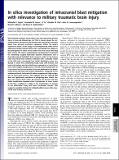In Silico Investigation of Intracranial Blast Mitigation with Relevance to Military Traumatic Brain Injury
Author(s)
Nyein, Michelle K.; Jason, Amanda M.; Yu, Li; Pita, Claudio M.; Moore, David Francis; Joannopoulos, John; Radovitzky, Raul A; ... Show more Show less
DownloadNyein-2010-In silico investigation of intracranial blast mitigation with relevance military traumatic brain injury.pdf (1.648Mb)
PUBLISHER_POLICY
Publisher Policy
Article is made available in accordance with the publisher's policy and may be subject to US copyright law. Please refer to the publisher's site for terms of use.
Terms of use
Metadata
Show full item recordAbstract
Blast-induced traumatic brain injury is the most prevalent military injury in Iraq and Afghanistan, yet little is known about the mechanical effects of blasts on the human head, and still less is known about how personal protective equipment affects the brain’s response to blasts. In this study we investigated the effect of the Advanced Combat Helmet (ACH) and a conceptual face shield on the propagation of stress waves within the brain tissue following blast events. We used a sophisticated computational framework for simulating coupled fluid–solid dynamic interactions and a three-dimensional biofidelic finite element model of the human head and intracranial contents combined with a detailed model of the ACH and a conceptual face shield. Simulations were conducted in which the unhelmeted head, head with helmet, and head with helmet and face shield were exposed to a frontal blast wave with incident overpressure of 10 atm. Direct transmission of stress waves into the intracranial cavity was observed in the unprotected head and head with helmet simulations. Compared to the unhelmeted head, the head with helmet experienced slight mitigation of intracranial stresses. This suggests that the existing ACH does not significantly contribute to mitigating blast effects, but does not worsen them either. By contrast, the helmet and face shield combination impeded direct transmission of stress waves to the face, resulting in a delay in the transmission of stresses to the intracranial cavity and lower intracranial stresses. This suggests a possible strategy for mitigating blast waves often associated with military concussion.
Date issued
2010-11Department
Massachusetts Institute of Technology. Institute for Soldier Nanotechnologies; Massachusetts Institute of Technology. Department of Aeronautics and Astronautics; Massachusetts Institute of Technology. Department of Electrical Engineering and Computer Science; Massachusetts Institute of Technology. Department of PhysicsJournal
Proceedings of the National Academy of Sciences of the United States of America
Publisher
National Academy of Sciences
Citation
Nuein, Michelle K. et al. "In silico investigation of intracranial blast mitigation with relevance to military traumatic brain injury" PNAS 2010 107: 20703-20708.
Version: Final published version
ISSN
0027-8424
1091-6490